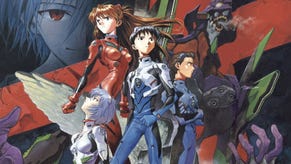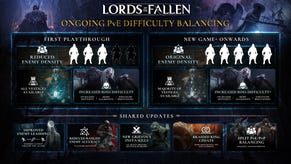Tearaway: how arts & crafts gave birth to the Vita's most charming asset - interview
Media Molecule has crafted a charming, unique experience in Tearaway. VG247's Dave Cook speaks with the studio to find out how arts and crafts sessions at the Guildford office gave rise to the game's mechanics and style.
Whenever I hear anecdotes about life around the Media Molecule office it always sounds like a cracking place to work. It's an environment where free-thinking, experimentation and creation is regularly encouraged, and that's unsurprising seeing as the same team made LittleBigPlanet, a title that places creativity at its core.
The idea of putting creation in the player's hands has also bled into its PS Vita debut Tearaway. While you won't be making full levels or games as such, there is still room for creative freedom and real, tangible player involvement thanks to the handheld's touch, camera and microphone features. It's a superb showcase of what Sony's device is capable of, and it bears a papercraft aesthetic unlike any I've seen before.
I was lucky enough to play Tearaway for the first time last month and I came away feeling charmed and entertained. There's something disarming about its artful world and the way it folds, curls and crumples as hero Iota trots along on his merry way. Colourful flowers bloom when you skip past them as streamers flutter on the breeze, while paper critters scamper around the wafting undergrowth.
It's a joyous place to be, and I asked Media Molecule's creative lead Rex Crowle for some insight into how the team made it all happen, and if they actually built any of the world with actual paper before committing it to code. "Well," he began, "in the early stages we hadn't actually, fully built our paper engine. We did actually have to build a lot of the stuff with paper so we could get a good idea of how it works.
"It was like building bridges or something similar to learn more about tolerances. At what point does it start to buckle and how - even if you try and make something physically perfect - if you look closely the glue starts to unstick a bit and if you press it squidges.
"We did all of that stuff while at the same time building the engine to simulate all of that stuff. Once the engine was done we could sort of put aside our papercraft, which was a massive fire hazard all around our desks [laughs] then just work digitally. We'd just take a sheet of paper and start building a world inside the game just one piece at a time."
The effort taken by Media Molecule to understand how paper works from a practical standpoint and how it can be used to create intricate objects has resulted in Tearaway's distinct style. Crowle said of the studio's attempts to keep the team artistically motivated, "We have a life-drawing room. It's kind of funny because sometimes you have an interview and you're trying to find a meeting room and you go, 'That one's not free. That one's not free,' then you kind of open the next door and there's no one in there, but there's just all these drawings of nudes and stuff. It keeps them a little bit on edge as they're being asked about their experience of shader technology."
Moving swiftly on; Tearaway's charm is also backed up through Media Molecule's expert application of the PS Vita's bespoke controls. You genuinely do feel creative and involved as you poke and prod the world to guide Iota along his path. You'll often see elements within the landscape painted in the same pattern seen on the handheld's rear touch-pad, meaning you can simply tap it to make things happen. Similarly, objects controlled by tapping the screen are painted in a finger-print design. It's devilishly clever, yet so simple.
“When I first saw the hardware it was a couple of bits of wire and the boards, but you could touch the pad on the back like ‘Wow okay,’ let’s use that. It was just something you couldn’t do, so we really liked focusing on that idea. Over time the game went in different directions, with different styles and actions you could do with your fingers.”
You can tap the rear pad to launch Iota off trampolines, or use it to burst your finger through the ground. Pulling two fingers apart will open up gift boxes, you can slide the screen to scratch giant DJ decks - which also messes up the soundtrack - and trace lines to cut out paper shapes then apply them to the world. All of this content appeared in the short demo I played, and I was advised that I hadn't even seen the half of what's possible. I'm eager to play the final code to see what the other applications consist of.
"We sometimes have that 'game jam' style process where everyone able to pitch ideas in and experiment with stuff," Crowle said of how the studio canvasses its staff for new concepts. "But obviously there's times where you really need to focus on bringing it all together and bringing it to something cohesive, but there are other times where we say, 'Oh we need some fresh ideas,' and then everyone starts experimenting with strange throwaway ideas."
On the PS Vita as a piece of hardware and how it drove the creative process, Crowle continued, "It's very powerful so naturally you have to make the game beautiful. I haven't been able to play anything other than Tearaway for a long time but I've seen screenshots of Killzone and it's just unbelievable. Touch has also helped us create a very rubbery, responsive type of game with all of the touchy-feely dexterous stuff inside of that.
"When I first saw the hardware it was a couple of bits of wire and the boards, but you could touch the pad on the back like 'Wow okay,' let's use that. It was just something you couldn't do, so we really liked focusing on that idea. Over time the game went in different directions, with different styles and actions you could do with your fingers." He told me that at one point movement required touch, but that constantly keeping a finger on the screen grew tiring. For Crowle and his team, Tearaway simply had to be both technologicreaally and ergonomically sound.
It's a comfortable device to hold today, but the Vita's final form didn't happen over-night. Much like Mark Cerny's quest to consult Sony's first-party studios about what they wanted from PS4, Media Molecule was also asked to help formulate the handheld. Crowle recalled, "Seeing each hardware revision as they were done revealed it to be a pretty sexy machine with all curves and shiny bits, and the screen eventually became an actual screen." In the end the ultimate feature set sparked the teams imagination, resulting in Tearaway's inventive selection of tools.
Opinions will forever be divided on the PS Vita - as they are on all consoles - but I have to admit that I've never played a game on the device that is as ingenious in its application of hardware features. You don't just stay engaged in Tearaway because the gameplay or plot are appealing - like you do in most games - but because you are constantly asked to participate in new, physical mechanics that result in visible feedback within the world. It's proper immersion.
Tearaway is a game that makes you feel like a kid again in art class. To beat it you'll have to create, draw, cut, push, pull, drag, tilt, rub, shake, take photos, shout into the mic and do all the typical 'game' stuff on top of that. This may sound like a selection box of gimmicks to John Q. FPS, but for kids and the charmed at heart there's absolutely no reason why Media Molecule's paper land won't fill you with joy.
Tearaway releases exclusively on PS Vita in Europe and the States on November 22.











